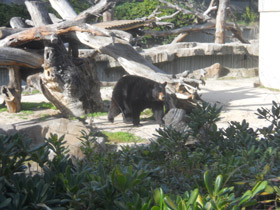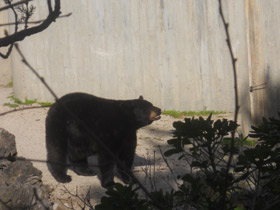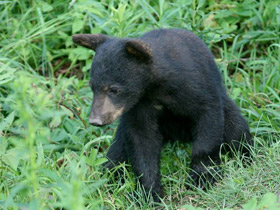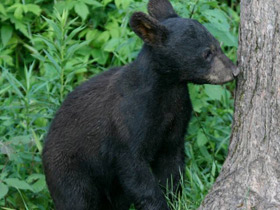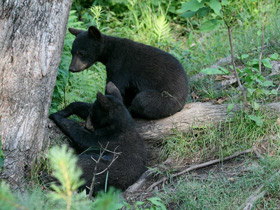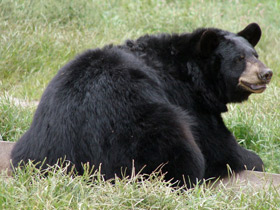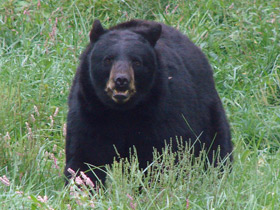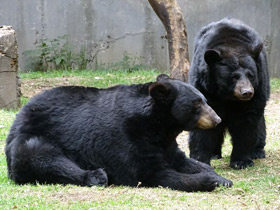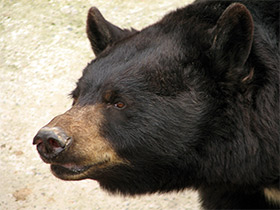The American black bear or the black bear (Ursus americanus)
American black bear видео
The American black bear (Ursus americanus), also known as the black bear, is a species of medium-sized bear endemic to North America. It is the continent's smallest and most widely distributed bear species. The American black bear is an omnivore, with a diet varying greatly depending on season and location. It typically lives in largely forested areas, but will leave forests in search of food, and is sometimes attracted to human communities due to the immediate availability of food.
The International Union for Conservation of Nature (IUCN) lists the American black bear as a least-concern species, due to its widespread distribution and a large population estimated to be twice that of all other bear species combined. Along with the brown bear (Ursus arctos), it is one of only two modern bear species not considered by the IUCN to be globally threatened with extinction.
Taxonomy and evolution
Despite living in North America, American black bears are not closely related to brown bears and polar bears; genetic studies reveal that they split from a common ancestor 5.05 million years ago (mya). American and Asian black bears are considered sister taxa and are more closely related to each other than to the other modern species of bears. According to recent studies, the sun bear is also a relatively recent split from this lineage.
Distribution and description
Ursus americanus has a very wide distribution in North America, from northern Alaska and Canada to central Mexico and from the Atlantic to the Pacific coasts. Ursus americanus inhabits diverse lowland and montane forests (foraging for food, occasionally venturing into open areas - grasslands, marshes, burned areas and river valleys - and ascending to 3,000 m in the mountains.
It hibernates in winter, establishing a den under tree roots, in rock crevices or in caves, and covering it with dry leaves and grass. Ursus americanus is usually territorial and solitary, the exception being females with cubs that form a kind of nursery.
They differ from brown bears in their soft black fur and smaller size: an adult male is between 1.4 and 2 m long and can weigh up to 300 kg, while females are smaller, weighing up to 240 kg. Other differences include a tapering muzzle and tall limbs with short feet.
Nutrition
Ursus americanus feeds mainly on plants, a variety of insects (ants, wasps, bees and termites) and their larvae, as well as rodents, rabbits, small ungulates and fish (salmon), occasionally attacking livestock.
The diet of Ursus americanus includes acorns, hazelnuts, chestnuts, various berries (blueberries, cranberries, raspberries, strawberries, rowan, wild grapes, etc.) and herbaceous plants (lupine, mallow, meadowsweet, dandelion, clover, etc.). Ursus americanus often approaches human dwellings and selects food scraps, without disdaining carrion.
Reproduction
Reproduction in Ursus americanus lasts 220 days, and the embryo does not begin to develop until autumn and only if the female has accumulated sufficient fat.
Between 1 and 5 (more often 2-3) young are born in January-February, during winter sleep. They are very small, weighing only 200-450 g, which is one of the smallest offspring relative to adults in mammals.
In spring, when the female and her cubs emerge from the den, they grow considerably, weighing between 2 and 5 kg. The pups become independent in autumn, but remain with their mother until the following summer.
When a female goes into heat again, she moves the cubs away from her territory. Females usually have pups every 2 years; in bad years, the break may be 3 to 4 years.
Males do not participate directly in the care of their cubs, but still unintentionally help the female bear by chasing other males away from their territory.
Subspecies
Sixteen subspecies are traditionally recognized; however, a recent genetic study does not support designating some of these, such as the Florida black bear, as distinct subspecies. Listed alphabetically according to subspecific name:
- Olympic black bear (Ursus americanus altifrontalis) - the Pacific Northwest coast from central British Columbia through northern California and inland to the tip of northern Idaho and British Columbia.
- New Mexico black bear (Ursus americanus amblyceps) - Colorado, New Mexico, western Texas and the eastern half of Arizona into northern Mexico and southeastern Utah.
- Eastern black bear (Ursus americanus americanus) - Eastern Montana to the Atlantic coast, from Alaska south and east through Canada to Maine and south to Texas. Thought to be increasing in some regions. Common to Eastern Canada and the eastern U.S. wherever suitable habitat is found. A large-bodied subspecies; almost all specimens have black fur. May very rarely sport a white blaze on the chest.
- California black bear (Ursus americanus californiensis) - the mountain ranges of southern California, north through the Central Valley to southern Oregon. Able to live in varied climates: found in temperate rain forest in the north and chaparral shrubland in the south. Small numbers may feature cinnamon-colored fur.
- Haida Gwaii black bear or Queen Charlotte Islands black bear (Ursus americanus carlottae) - Haida Gwaii (formerly the Queen Charlotte Islands) and Alaska. Generally larger than its mainland counterparts with a huge skull and molars and found only in a black color phase.
- Cinnamon bear(Ursus americanus cinnamomum) - Colorado, Idaho, western Montana and Wyoming, eastern Washington and Oregon and northeastern Utah. Has brown or reddish-brown fur, reminiscent of cinnamon.
- Glacier bear or blue bear (Ursus americanus emmonsii) - Southeastern Alaska. Stable. Distinguished by its fur being silvery-gray with a blue luster found mostly on its flanks.
- East Mexican black bear (Ursus americanus eremicus) - Northeastern Mexico and U.S. borderlands with Texas. Critically Endangered. Most often found in Big Bend National Park and the desert border with Mexico. Numbers unknown in Mexico, but are presumed to be very low.
- Florida black bear (Ursus americanus floridanus) - Florida, southern Georgia, Alabama and Mississippi (except the southern region). Has a light brown nose and shiny black fur. A white blaze on the chest is common in this subspecies. An average male weighs 136 kg (300 lb).
- Newfoundland black bear (Ursus americanus hamiltoni) - Newfoundland. Generally bigger than its mainland relatives, ranging in size from 90 to 270 kg (200 to 600 lb) and averaging 135 kg (298 lb). It has one of the longest hibernation periods of any bear in North America. Known to favor foraging in fields of Vaccinium species.
- Kermode bear or island white bear, spirit bear (Ursus americanus kermodei) - the central coast of British Columbia. Approximately 10% of the population of this subspecies have white or cream-colored coats due to a recessive gene and are called "Kermode bears", "island white bears", or "spirit bears". The other 90% appear as normal-colored black bears.
- Louisiana black bear (Ursus americanus luteolus) - Eastern Texas, Louisiana and southern Mississippi. The validity of this subspecies has been repeatedly disputed. Has relatively long, narrow and flat skull and proportionately large molars. Prefers hardwood bottom forests and bayous as habitat.
- West Mexican black bear (Ursus americanus machetes) - north-central Mexico.
- Kenai black bear (Ursus americanus perniger) - the Kenai Peninsula, Alaska. Considered an "Apparently Secure Subspecies" by NatureServe.
- Dall Island black bear (Ursus americanus pugnax) - Dall Island in the Alexander Archipelago, Alaska.
- Vancouver Island black bear (Ursus americanus vancouveri) - Vancouver Island, British Columbia. Darker and slightly bigger than the other five subspecies found in British Columbia; it is most common in the north, but appears occasionally in the southern parts of Vancouver Island.

















